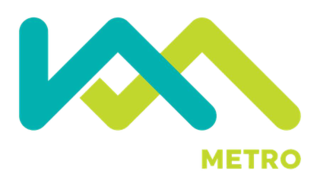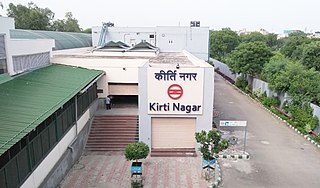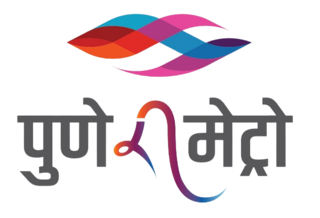
The Mumbai Metro is a rapid transit (MRT) system serving the city of Mumbai and the wider Mumbai Metropolitan Region in Maharashtra, India.

The Kochi Metro is a rapid transit system serving the city of Kochi and the wider Kochi Metropolitan Region in Kerala, India. It was opened to the public within four years of starting construction, making it one of the fastest completed metro projects in India. The Kochi metro project is the first metro system in the country which connects rail, road and water transport facilities. It is also the first metro rail system in India to be operated using the Communication-Based Train Control (CBTC) signalling system, which requires minimum human intervention. The Kochi Water Metro is integrated with the Kochi Metro, which also serves as a feeder service to the suburbs along the rivers where transport accessibility is limited.

Pune Metro is a mass rapid transit system serving the city of Pune, India. The system comprises 3 lines with a combined length of 54.14 km (33.64 mi), of which 24.12 km (14.99 mi) on two lines are operational as of August 2023. The extended metro line from Ruby Hall Clinic to Ramwadi, including the Bund Garden, Kalyani Nagar and Ramwadi metro stations, covering a distance of 6 km, was inaugrated on 6 March 2024. The 16.59 km (10.31 mi) Purple Line from PCMC Bhavan to Swargate runs on an elevated viaduct between PCMC Bhavan to Range Hills, from where it goes underground. The Aqua Line runs from Vanaz to Ramwadi covering a distance of 14.66 km (9.11 mi) on an elevated viaduct. The 23.33 km (14.50 mi) elevated Line 3 will run from the Rajiv Gandhi Infotech Park in Hinjawadi via Balewadi to Civil Court. All three lines will align at the Civil Court interchange station.

The Lucknow Metro is a mass rapid transit (MRT) system in Lucknow, Uttar Pradesh, India. The metro is owned and operated by the Uttar Pradesh Metro Rail Corporation (UPMRC). The frequency of the metro's services is around 5 - 7 minutes.

Ahmedabad Metro is a rapid transit system for the cities of Ahmedabad and Gandhinagar in Gujarat state of India.

The Green Line is a metro rail line of the Delhi Metro, a rapid transit system in Delhi, India. The line consists of 24 stations covering a total length of 28.79 km. It runs between Inderlok and Brigadier Hoshiyar Singh with a branch line connecting the line's Ashok Park Main station with Kirti Nagar station.

Urban rail transit in India plays an important role in intracity transportation in the major cities which are highly populated. It consists of rapid transit, suburban rail, monorail, and tram systems.

The Kirti Nagar metro station is an interchange station between the Blue Line and Green Line of Delhi Metro. It is one of the eastward terminal stations of the Green Line, the other being Inderlok, and was opened as a part of a small 3.41 km (2.12 mi) branch from this station to Ashok Park Main station on 27 August 2011. This allowed passengers to easily transfer between the Red Line and Blue Line of the network.

The Delhi Metro is a mass rapid transit system which serves Delhi and its adjoining satellite cities, such as Ghaziabad, Faridabad, Gurugram, Noida and Bahadurgarh, in the National Capital Region of India. The system consists of 10 colour-coded lines serving 256 stations, with a total length of 350.42 kilometres (217.74 mi). It is India's largest and busiest metro rail system and the second-oldest, after the Kolkata Metro. The metro has a mix of underground, at-grade, and elevated stations using broad-gauge and standard-gauge tracks. The metro makes over 4,300 trips daily.

Nagpur Metro is a rapid transit system for the city of Nagpur, Maharashtra, India. Phase I of the metro project cost was estimated to cost ₹8,650 crore but the final project cost incurred was ₹9,279 crore (US$1.1 billion). In February 2014, the Government of Maharashtra gave approval for the Metro project, while the Government of India's Ministry of Urban Development had given "In Principle" approval for the project. On 20 August 2014, Union Cabinet gave approval for the development of the project, and the Prime Minister laid the foundation stone on 21 August. Construction began on 31 May 2015, with trial run beginning on 30 September 2017.
The Surat Metro is an under-construction rapid transit rail system for Surat in the Surat Metropolitan Region, Gujarat state of India. Two corridors with a combined length of 40.35 kilometers are under construction since 18 January 2021. The project is expected to be completed by December 2027 at an estimated cost of ₹12,020.32 crore (US$1.4 billion).

The Noida Metro is a rapid transit system connecting the twin cities of Noida and Greater Noida in Gautam Buddh Nagar, Uttar Pradesh, India. The metro network consists of one line, with a total length of 29.7 kilometres (18.5 mi) serving 21 stations. The system has all elevated stations using standard-gauge tracks.

The Pink Line is a metro rail line of the Delhi Metro, a rapid transit system in Delhi, India. It consists of 38 metro stations from Majlis Park to Shiv Vihar, both in North Delhi.

The Magenta Line is a metro rail line of the Delhi Metro, a rapid transit system in Delhi, India and the first driverless metro in India.The line is laid on most of the parts of South Delhi and is mostly underground.The total length of the line is 37.46 kilometers (23.28 mi) and it consists of 25 metro stations from Janakpuri West to Botanical Garden, out of which 10 are elevated and the rest are underground. Unlike the Airport Metro Express, this line directly serves Terminal 1 of the Indira Gandhi International Airport.
The Meerut Metro is an under-construction rapid transit system, which will serve the city of Meerut, Uttar Pradesh, India. It is being built in two phases, of which the first phase with the first line will cover 23.6 km (14.7 mi) with 13 stations, from Modipuram to Meerut South. It will have nine elevated, three underground stations, one at-grade station as the depot station at Modipuram, and four stations integrated with the Delhi–Meerut Regional Rapid Transit System on a single corridor, making the metro the first such rapid transit system in India to be merged directly with a regional transit system. The second phase will include a second line covering 15 km (9.3 mi) from Shradhapuri Phase-II to Jagrati Vihar, with 12 stations, out of which seven will be elevated and five will be underground, thereby taking the overall length to 38.6 km (24.0 mi). The metro will also be the fastest metro of India, at an operational speed of 120 km/h (75 mph).

The Delhi–Meerut Regional Rapid Transit System is a partially operational 82.15 km (51.05 mi)-long semi high-speed rail and regional transit corridor that will connect the National Capital Region (NCR) cities of Delhi, Ghaziabad and Meerut. It is the first of the four rapid rail corridors planned under the first phase of the RapidX project managed by the National Capital Region Transport Corporation (NCRTC). Designed to allow a maximum speed of 180 km/h (110 mph), the distance between Delhi and Meerut will be covered in less than 60 minutes. The project is being executed at a cost of ₹30,274 crore (US$3.6 billion). It will start from Jangpura as the starting station, run through Sarai Kale Khan, the terminal for the three planned corridors, both in Delhi, and end in Modipuram in Meerut. It will have 16 stations and two depots at Duhai and Modipuram.
The Indigo Line is a proposed line of the Delhi Metro. It will provide improved connections to northern, north-western and central Delhi with eastern, south-eastern Delhi and Noida, to decrease the increasing traffic, congestion and pollution on roads. It will act as a link line, by joining seven lines–Red, Green, Magenta, Yellow, Orange, Violet and Blue lines with each other. It will start from Inderlok and end in Indraprastha. It will be 12.57 km (7.81 mi)-long with eleven stations, out of which six will be underground and five wil be elevated. Construction is expected to begin in 2024, as part of the fourth phase of the Delhi Metro's development, and is slated to be completed by 2026.

Line 3 of the Pune Metro is the third line of the city's under-construction mass transit network. It will run from Civil Court, Pune to Megapolis Pune in Hinjawadi. The 23.3 km (14.5 mi) line will be completely elevated and will have 23 stations and will align with the MahaMetro lines at the Civil Court interchange station. The construction will be taken up in two phases, the section between Hinjawadi and Balewadi is expected to be taken up first, followed by the section between Balewadi and Civil Court, Shivaji Nagar. A metro car shed will be built in Hinjawadi. The MIDC will provide 55 acres of land in Hinjawadi for setting up a Metro rail depot. On 3 August 2018, Pune Metropolitan Region Development Authority (PMRDA) announced the final bidder for the project — the joint venture Tata Realty-Siemens. and Siemens On 3 October 2018, Tata Realty-Siemens were awarded the contract to execute the project on a design, build, finance, operate and transfer model. The formal concession agreement was signed in September 2019 with the construction expected to begin in March 2020. The project is set to be completed in March 2025.
The Delhi Metroneo is a planned 19.09 km (11.86 mi) Metrolite system with 21 stations that will connect Kirti Nagar to Bamnoli Village via Mayapuri, Hari Nagar, Tihar Jail, Dwarka Sector 2, Sector 7, Sector 6, Sector 20, and Sector 23, and the Dwarka ECC.Earlier the corridor was planned as a Metrolite but in November 2020, the project was cancelled, replacing the corridor with Metro Neo by the DMRC officials. It will be designed as per MoHUA's Metrolite specifications, and will be much cheaper to construct because of its lower speeds and carrying capacities compared to regular metros. Detailed Project Report (DPR) for this line was approved by DMRC's board in October 2019, and is currently awaiting the Delhi Government's approval.
The Golden Line(Line 10) is an under-construction rapid transit line of the Delhi Metro. It will connect southern Delhi directly with Indira Gandhi International Airport to relieve the increasing traffic, congestion and pollution on roads. It will start from Terminal 1-IGI Airport, which was previously planned from Delhi Aerocity, and end in Tughlakabad. It will be 25.82 km (16.04 mi) long with 16 stations, out of which four will be elevated and 12 will be underground. Construction began on the line in June 2022, as part of the fourth phase of the Delhi Metro's development, and is expected to be completed by March 2026.













